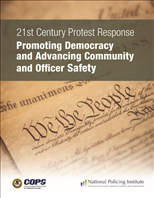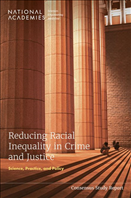The Law Enforcement Knowledge Lab
The Knowledge Lab will serve as a reliable national resource to improve public safety through effective crime-fighting strategies, robust constitutional policing, and stronger community relationships.
United States Conference of Mayors Report on Police Reform and Racial Justice: Transparency and Accountability to Reinforce Constitutional Policing
True police reform will not come about through improved policies and training alone. We must ensure that police fulfill their commitments to protect the residents they serve and that police build trust and legitimacy through transparency, engagement, and accountability.
Reforming Patterns of Unconstitutional Policing: Enforcement of 34 U.S.C. § 12601
This document provides background 34 U.S.C. §12601 (Section 12601), which serves as the primary federal law aiming to ensure that law enforcement agencies comply with the Constitution.
21st Century Protest Response: Promoting Democracy and Advancing Community and Officer Safety
The First Amendment to the U.S. Constitution guarantees the people's right "peaceably to assemble, and to petition the government for a redress of grievances," and many political, economic, and social concerns throughout our nation's history have been confronted and ameliorated by marches, sit ins, rallies, demonstrations, and protests. Law enforcement agencies play a critical role in preserving and protecting these rights, but they must also identify when intervention is necessary in order to maintain safety and public order. This publication provides recommendations for state, local, tribal, and territorial law enforcement agencies for addressing the challenges of mass demonstrations in the 21st century and responding with the goal of protecting the right to protest while safeguarding property as well as preserving officer and community safety.
Community Based Violence Intervention and Prevention Initiative Implementation Checklist
Developed with support from the Bureau of Justice Assistance, the Community Violence Intervention (CVI) Implementation Checklist captures background information about CVI efforts, CVI guiding principles, and details on the following specific steps to take when implementing CVI programs: Step 1: Engage Community Members and Conduct a Community Violence Assessment Step 2: Form a Community Collaboration Step 3: Implement CVI Step 4: Setting CVI Up for Success Step 5: Measure Success Step 6: Sustain Success and Continuous Improvement
Reducing Racial Inequality in Crime and Justice: Science, Practice and Policy
The history of the U.S. criminal justice system is marked by racial inequality and sustained by present day policy. Large racial and ethnic disparities exist across the several stages of criminal legal processing, including in arrests, pre-trial detention, and sentencing and incarceration, among others, with Black, Latino, and Native Americans experiencing worse outcomes. The historical legacy of racial exclusion and structural inequalities form the social context for racial inequalities in crime and criminal justice. Racial inequality can drive disparities in crime, victimization, and system involvement. Reducing Racial Inequality in Crime and Justice: Science, Practice, and Policy synthesizes the evidence on community-based solutions, noncriminal policy interventions, and criminal justice reforms, charting a path toward the reduction of racial inequalities by minimizing harm in ways that also improve community safety. Reversing the effects of structural racism and severing the close connections between racial inequality, criminal harms such as violence, and criminal justice involvement will involve fostering local innovation and evaluation, and coordinating local initiatives with state and federal leadership. This report also highlights the challenge of creating an accurate, national picture of racial inequality in crime and justice: there is a lack of consistent, reliable data, as well as data transparency and accountability. While the available data points toward trends that Black, Latino, and Native American individuals are overrepresented in the criminal justice...
2021 PSP Virtual Violent Crime Summit: Constitutional and Proactive Policing
The PSP Virtual Violent Crime Summit took place on April 21-22, 2021 and convened criminal justice leaders and key stakeholders from PSP sites, U.S. Department of Justice (DOJ) officials, subject-matter experts (SMEs), and other field-based partners to examine topics of interest and additional evidence-based practices to increase public safety, reduce violence, and enhance partnerships in the participating communities. Session Description: Community partnerships and public trust are critical in enabling officers to perform the essential functions of policing and achieving a sustained impact on public safety. Without the community’s cooperation, police departments may be unable to solve crimes and obtain convictions. How do departments balance building public trust, strengthening community partnerships, and reinforcing constitutional principles while exercising legitimate police powers? This session provides strategies and practical examples to address these and other important questions about the role of police-community relationships in enhancing public safety.
Task Force on 21st Century Policing – A Renewed Call to Action
On April 25, 2023, former members of President Obama’s Task Force on 21st Policing released a renewed call to action to ensure ongoing and evidence-based approaches to policing reform.
What Works in De-Escalation Training
The third plenary session focused on the Integrating Communications, Assessment, and Tactics (ICAT) training program for law enforcement. The plenary brought together the entire life cycle of an evidence-based program from design and initial implementation to evaluation and, eventually, improvements to the program based on the research.








